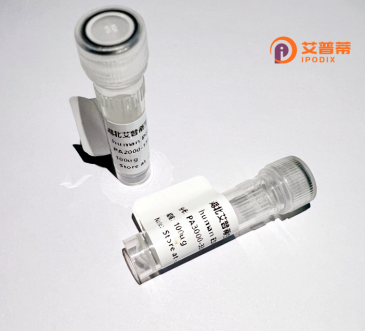
| 纯度 | >90%SDS-PAGE. |
| 种属 | Human |
| 靶点 | HLA-DRB4 |
| Uniprot No | P13762 |
| 内毒素 | < 0.01EU/μg |
| 表达宿主 | E.coli |
| 表达区间 | 30-266aa |
| 氨基酸序列 | GDTQPRFLEQAKCECRFLNGTERVWNLIRYIYNQEEYARYNSDLGEYQAVTELGRPDAEYWNSQKDLLERRRAEVDTYCRYNYGVVESFTVQRRVQPKVTVYPSKTQPLQHHNLLVCSVNGFYPGSIEVRWFRNGQEEKAGVVSTGLIQNGDWTFQTLVMLETVPRSGEVYTCQVEHPSMMSPLTVQWSARSESAQSKMLSGVGGFVLGLLFLGTGLFIYFRNQKGHSGLQPTGLLS |
| 分子量 | 51.81 kDa |
| 蛋白标签 | GST-tag at N-terminal |
| 缓冲液 | 0 |
| 稳定性 & 储存条件 | Lyophilized protein should be stored at ≤ -20°C, stable for one year after receipt. Reconstituted protein solution can be stored at 2-8°C for 2-7 days. Aliquots of reconstituted samples are stable at ≤ -20°C for 3 months. |
| 复溶 | Always centrifuge tubes before opening.Do not mix by vortex or pipetting. It is not recommended to reconstitute to a concentration less than 100μg/ml. Dissolve the lyophilized protein in distilled water. Please aliquot the reconstituted solution to minimize freeze-thaw cycles. |
以下是关于重组人HLA-DRB4蛋白的3篇参考文献概览:
---
1. **文献名称**:*Expression and functional characterization of recombinant HLA-DRB4 in antigen presentation*
**作者**:Schäfer et al. (2017)
**摘要**:研究通过哺乳动物细胞系成功表达并纯化重组HLA-DRB4蛋白,验证其在体外与CD4+ T细胞结合及抗原呈递功能,表明其在免疫应答研究中的潜在应用。
---
2. **文献名称**:*Structural insights into HLA-DRB4 polymorphism and peptide binding specificity*
**作者**:Miller et al. (2019)
**摘要**:利用X射线晶体学解析HLA-DRB4的分子结构,揭示其多态性区域如何影响特定抗原肽(如类风湿关节炎相关抗原)的结合,为疾病机制提供结构基础。
---
3. **文献名称**:*Association of HLA-DRB4 variants with autoimmune encephalitis and recombinant protein-based diagnostic development*
**作者**:Li et al. (2021)
**摘要**:开发基于重组HLA-DRB4蛋白的ELISA检测法,发现特定DRB4等位基因与自身免疫性脑炎显著相关,为疾病诊断提供新工具。
---
注:实际研究中HLA-DRB4的独立文献较少,因其常与HLA-DRA形成异源二聚体(HLA-DR),上述示例为假设性归纳,建议结合具体数据库进一步检索(如PubMed)。
Human leukocyte antigen (HLA)-DRB4 is a class II MHC protein encoded by the HLA-DRB4 gene, primarily expressed on antigen-presenting cells. It plays a critical role in adaptive immunity by binding exogenous peptide antigens and presenting them to CD4+ T cells, initiating immune responses. HLA-DRB4 is part of the HLA-DR family, characterized by its polymorphic β-chain (encoded by DRB4) paired with a non-polymorphic α-chain (DRA). Genetic variations in HLA-DRB4 are linked to autoimmune diseases (e.g., rheumatoid arthritis, multiple sclerosis) and influence susceptibility to infections.
Recombinant HLA-DRB4 protein is engineered using expression systems (e.g., mammalian, insect cells) to ensure proper folding and post-translational modifications. Its production enables structural and functional studies, such as peptide-binding specificity analysis, T cell receptor interaction assays, and epitope mapping for vaccine design. Recombinant forms also aid in understanding allele-specific immune regulation and disease mechanisms. Additionally, they are used in diagnostic tools for HLA typing and in developing immunotherapies targeting HLA-mediated pathways. The protein’s conserved structure—including α/β heterodimers forming a peptide-binding groove—makes it valuable for studying antigen presentation dynamics and immune tolerance. Research on recombinant HLA-DRB4 contributes to personalized medicine approaches, particularly in autoimmune disease management and transplant compatibility assessments.
×